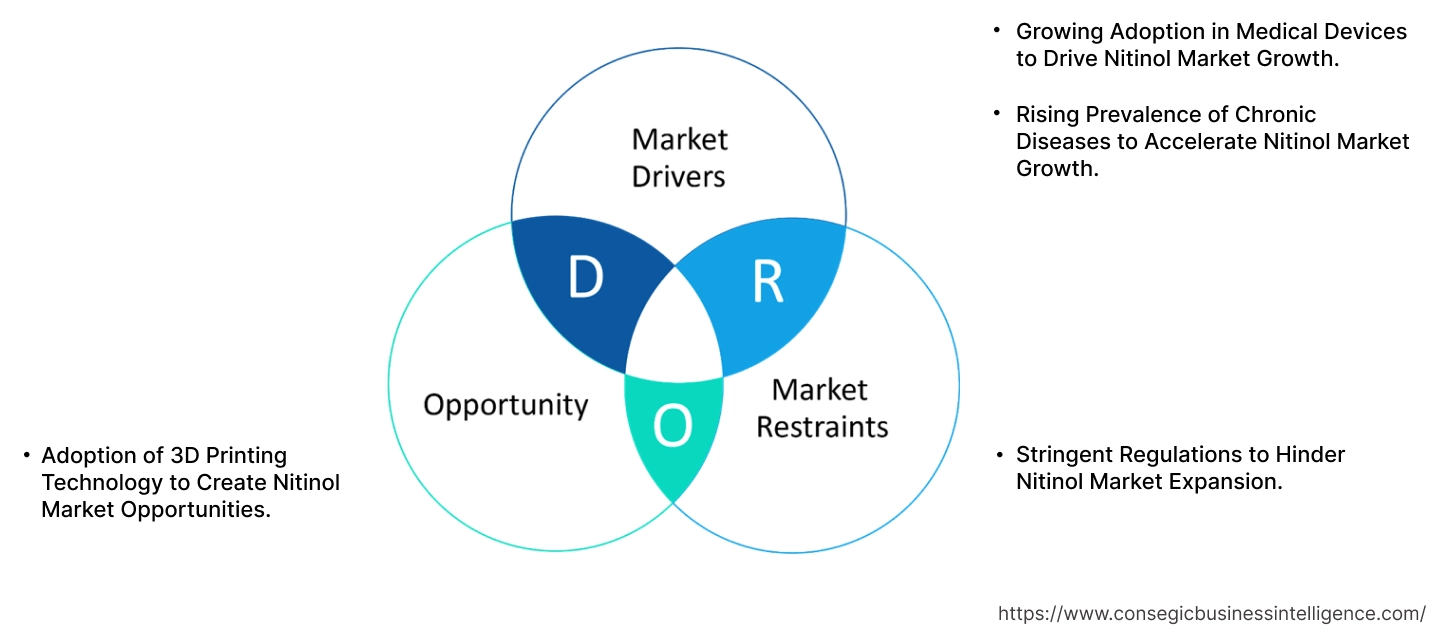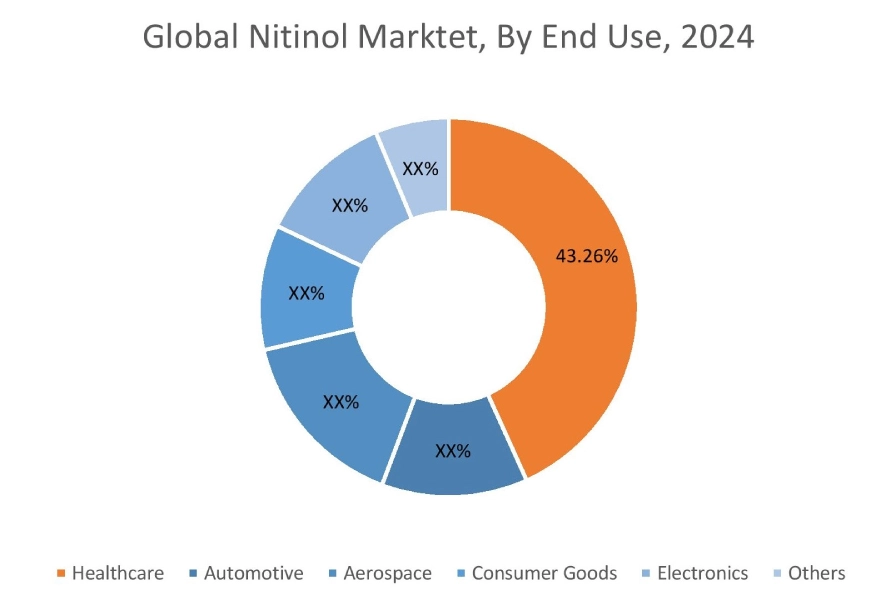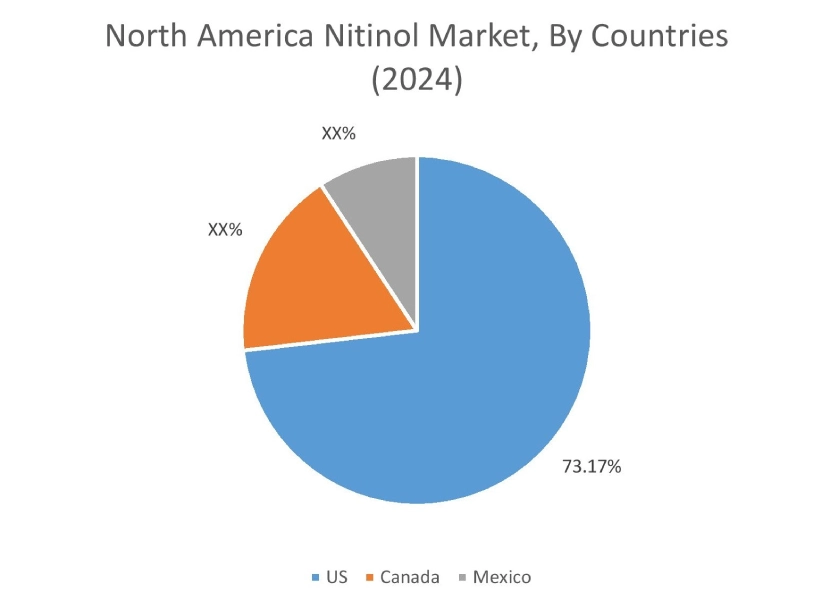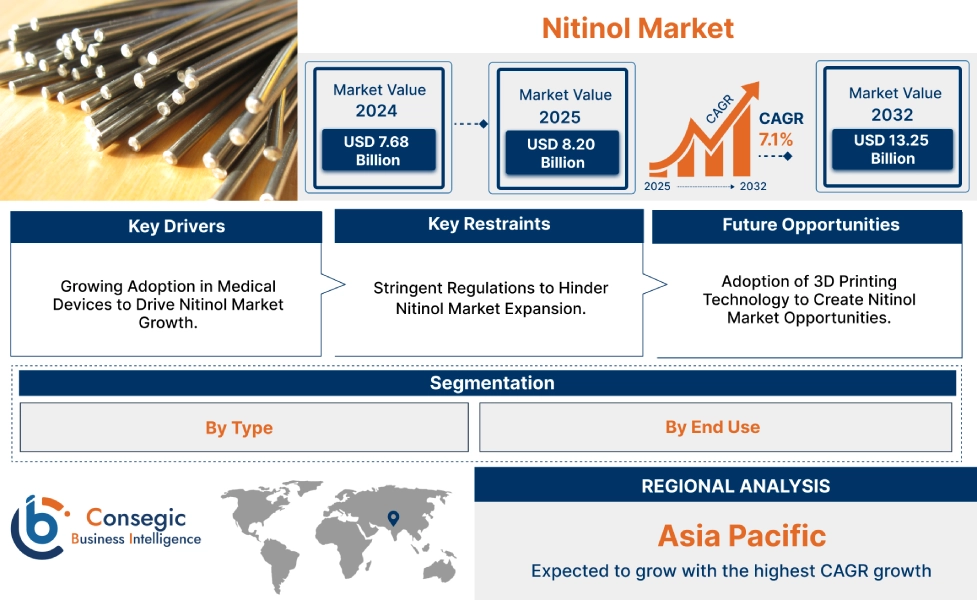Nitinol Market Size:
The Nitinol Market size is growing with a CAGR of 7.1% during the forecast period (2025-2032), and the market is projected to be valued at USD 13.25 Billion by 2032 from USD 7.68 Billion in 2024. Additionally, the market value for 2025 is attributed to USD 8.20 Billion.
Nitinol Market Scope & Overview:
Nitinol is a distinctive metal alloy composed primarily of nickel and titanium distinguished by its unique material properties. Its most notable characteristics are the shape memory effect, which allows it to return to a pre-defined shape upon heating after deformation. It also presents super elasticity which allows it to undergo large deformations and revert to its original form without permanent damage upon stress removal. Furthermore, this alloy exhibits excellent biocompatibility and corrosion resistance making it highly suitable for internal use within the human body. These combined attributes make it a crucial material in a diverse range of applications including medical device products such as self-expanding stents & guidewires, and specialized aerospace and consumer goods among others.
How is AI Impacting the Nitinol Market?
Artificial Intelligence is transforming the Nitinol market by accelerating material design, production optimization, and performance analysis. Through predictive modeling, AI helps researchers simulate Nitinol's shape-memory and superelastic properties under various conditions, reducing the need for costly trial-and-error experiments. In manufacturing, AI-powered process control systems enhance precision in temperature and composition adjustments, ensuring consistent alloy quality. Machine learning algorithms also predict fatigue behavior and improve product reliability in critical applications like medical devices and aerospace components. Furthermore, AI-driven data analytics supports the development of customized Nitinol solutions tailored to specific performance requirements. Overall, AI integration is improving innovation, efficiency, and quality in Nitinol production and application development.
Nitinol Market Dynamics - (DRO) :
Key Drivers:
Growing Adoption in Medical Devices to Drive Nitinol Market Growth.
Nitinol is distinguished by superelasticity that allows for the creation of minimally invasive devices which need to be compressed for delivery through small catheters and then self-expand to their predetermined shape once deployed within the body. This capability directly translates to reduced patient trauma and lower risks of complications. Consequently, the rising prevalence of chronic conditions often requires minimally invasive surgical procedures in turn fueling the adoption of nitinol-based medical devices such as stents, guidewires, retrieval devices among others. As the global demand for medical devices continues to rise, the industry's requirement for this alloy increase, thereby impacting market demand.
- For instance, according to data published by Medtech Europe, European medical device market has demonstrated consistent growth, averaging 5.7% annually over 2009-22.
Thus, as per the analysis, the growing market for this alloy in medical devices is fueling significant growth.
Rising Prevalence of Chronic Diseases to Accelerate Nitinol Market Growth.
Conditions such as cardiovascular diseases, including coronary artery disease and peripheral artery disease, neurological disorders including aneurysms among others are on the rise worldwide. These conditions necessitate medical interventions that often involve the use of advanced devices. Nitinol is distinguished with its unique shape memory and superelastic properties along with excellent biocompatibility. Hence, this alloy is suitable for a wide range of these critical medical applications such as self-expanding stents made from this alloy of nickel and titanium for treating vascular occlusions. As the global population ages and lifestyles contribute to a higher incidence of these diseases, the demand for medical solutions made from this alloy are increasing.
- For instance, according to Centers for Disease Control and Prevention, a growing segment of the American population is managing multiple chronic conditions, with 42% of individuals reporting two or more, and 12% living with at least five.
Thus, such a high prevalence of chronic diseases is impacting positively on the demand in nitinol market.

Key Restraints :
Stringent Regulations to Hinder Nitinol Market Expansion.
Stringent regulations serve as a significant impediment to market demand owing to its dominant application in the highly regulated medical device sector. Products containing this alloy such as those intended for implantation and critical medical procedures, must undergo rigorous testing and extensive approval processes mandated by regulatory bodies such as the U.S. Food and Drug Administration and the European Medicines Agency. These stringent requirements necessitate substantial investments in research, development, clinical trials, and meticulous documentation, which significantly prolong the time-to-market for new nitinol-based devices. The high cost of compliance, coupled with the complexity and unpredictable timelines of regulatory clearances, further deter innovation, limit market entry for smaller manufacturers, and ultimately limit the overall market expansion.
Future Opportunities :
Adoption of 3D Printing Technology to Create Nitinol Market Opportunities.
Nitinol is difficult to fabricate using conventional methods due to its unique superelasticity and stringent compositional control requirements. However, advancements in additive manufacturing techniques such as Selective Laser Melting (SLM) and Electron Beam Melting (EBM), are overcoming these issues. This allows for the precise creation of complex geometries and intricate lattice structures, creating potential for the development of highly customized and patient-specific medical implants. Furthermore, 3D printing also reduces material waste and potentially lowers manufacturing costs. Thus, the growing adoption of 3D printing is expected to open doors for the nitinol market trends.
- For instance, the number of 3D printing and additive manufacturing devices is forecast to grow to more than 2.7 million by 2030.
Henceforth, the growing adoption of 3D printing is creating lucrative nitinol market opportunities over the forecast period.
Nitinol Market Segmental Analysis :
By Type:
Based on type, the market is categorized into shape-memory nitinol and superelastic nitinol.
Trends in Type:
- The preference for superelastic nitinol due to its flexibility along with the ability to be compressed and then self-expand across a variety of procedures is growing trend.
The superelastic nitinol segment accounted for the largest nitinol market share in 2024 and is expected to grow at the fastest CAGR over the forecast period.
- The superelastic nitinol holds prominence due to its flexibility, the ability to adhere reversible deformations amongst others. This makes it a suitable choice for being used in minimally invasive medical procedures.
- Its flexibility, along with the capacity to be compressed and then self-expand makes it an ideal option for a wide range of medical devices such as stents, catheters, guidewires, and others.
- For instance, according to Eurostat, 1.1 million transluminal coronary angioplasty procedures were conducted in the European Union Countries in 2021 and are expected to increase at a considerate growth over the forecast period.
- Thus, as per the nitinol market analysis, the superelastic nitinol segment is dominating the nitinol market demand.
By End Use:
The End Use segment is categorized into healthcare, automotive, aerospace, consumer goods, electronics, and others.
Trends in the End Use
- The properties offered by nitinol such as biocompatibility and superelasticity, make it suitable for minimally invasive surgery trend.
- The preference for compact actuators in applications such as thermal valves, active aerodynamics is growing.
The healthcare segment accounted for the largest nitinol market share of 43.26% in 2024.
- This dominance of healthcare end use sector is due to the utilization of nitinol in minimally invasive medical devices.
- The growing focus of manufacturers across the globe towards less invasive surgical procedures due to the factors such as reduced patient trauma, shorter hospital stays and others are contributing to the segmental revenue.
- In healthcare, particularly cardiovascular devices attribute to a major percentage as these devices require high adoption of this alloy in self-expanding stents, catheters, guidewires, amongst others. The rise in cardiovascular devices is further contributing to the segmental growth.
- For instance, according to Wiley, cardiovascular diseases has a prevalence rate of 7.5% in 2024, with nearly 30% of the population deceased due to these diseases.
- Thus, as per the aforementioned factors, the healthcare segment is dominating nitinol market demand.
The aerospace segment is expected to grow at the fastest CAGR over the forecast period.
- The growing preference in aerospace sector is due to the need for lightweight, efficient, and reliable components.
- Nitinol's properties of shape-memory is important for smart actuators that are necessary for applications such as adaptive flow control amongst others.
- In addition to this, the material's capacity for vibration damping along with the resilience in extreme environments are further contributing to the segmental growth.
- Moreover, investments in R&D are creating lucrative opportunities for wider commercial adoption.
- Thus, based on the market analysis, the aerospace segment is the fastest growing segment in the sector’s trends.

Regional Analysis:
The regional segment includes North America, Europe, Asia Pacific, the Middle East and Africa, and Latin America.

In 2024, North America accounted for the highest market share at 40.22% and was valued at USD 3.09 Billion and is expected to reach USD 4.83 Billion in 2032. In North America, the U.S. accounted for a market share of 73.17% during the base year of 2024. The upwards trajectory of regional share is primarily driven by the region's highly advanced medical device sector. The region benefits from a sophisticated healthcare infrastructure, significant investments in research and development, and the substantial presence of leading medical device manufacturers. The widespread adoption of medical devices, a key application area for Nitinol, is a primary driver within this region. This established industry readily integrates the alloy’s unique properties into advanced devices for minimally invasive surgeries, including cardiovascular stents, guidewires, and orthopedic implants, among others.
- For instance, according to MEDPAC, medical devices typically account for approximately 4% to 6% of the total healthcare expenditure in the United States

Thus, as per analysis, these factors collectively position North America as a key region for the market.
In Asia Pacific, the Nitinol industry is experiencing the fastest growth with a CAGR of 8.3% over the forecast period owing to the escalating prevalence of chronic diseases across its vast population. Nations such as China, India, and other Southeast Asian countries are witnessing a significant increase in chronic conditions such as cardiovascular diseases, diabetes, and orthopedic ailments among others. This rising disease burden directly results in the increased necessity for advanced medical interventions. As healthcare infrastructure improves and access to modern treatments expands in the region, the need for these high-performance, biocompatible solutions to manage chronic conditions is becoming increasingly critical. Collectively these factors fuel Asia Pacific Nitinol market analysis.
European market is defined by increasing adoption of minimally invasive surgeries across its advanced healthcare systems. The region's medical community is increasingly favoring these less invasive procedures due to benefits such as reduced patient recovery times, lower complication rates, and decreased healthcare costs. Alloy of nickel and titanium is an appropriate material for the flexible, self-expanding devices central to MIS. This growing preference for MIS consistently drives adoption of sophisticated Nitinol-based medical technologies throughout Europe. Hence, as per analysis, these factors collectively present a positive impact on the European market trends.
The Nitinol market expansion in Latin America is arising from advancements in additive manufacturing. The increasing adoption of 3D printing technologies offers a pathway to overcome some traditional manufacturing complexities associated with this alloy. This technology enables the creation of intricate, customized medical devices with reduced material waste and potentially lower production lead times. As Latin American countries invest in modernizing their healthcare systems and local manufacturing capabilities, the ability to leverage 3D printing for specialized implants and instruments is expected significantly accelerate market penetration and reduce reliance on costly imports, thereby driving the upward Nitinol market trend.
The market in Middle East and Africa is characterized by increasing healthcare expenditure. Governments and private sectors across the MEA are significantly investing in upgrading and expanding healthcare infrastructure, aiming to improve access to advanced medical treatments and services. This rise in spending directly translates to a greater procurement of modern medical devices, many of which leverage Nitinol's unique properties. As economic diversification efforts continue and populations grow, there's a growing necessity for sophisticated diagnostic and therapeutic solutions for prevalent chronic diseases. Consequently, this escalating healthcare investment is a pivotal factor driving market in the MEA region.
Top Key Players & Market Share Insights:
The Global Nitinol Market is highly competitive with major players providing products to the national and international markets. Key players are adopting several strategies in research and development (R&D) and product innovation to hold a strong position in the global Nitinol market. Key players in the Nitinol industry include
- Johnson Matthey (United Kingdom)
- ATI Materials (U.S)
- Resonetics (U.S)
- Daido Steel Co., Ltd. (Japan)
- Baoji ChuangXin Metal Materials Co.,Ltd (China)
- GEE SMA (China)
- Metalwerks (U.S.)
- Stanford Advanced Materials (U.S.)
- Fort Wayne Metals Research Products, LLC (U.S.)
- Confluent Medical Technologies (U.S.)
Nitinol Market Report Insights :
| Report Attributes | Report Details |
| Study Timeline | 2019-2032 |
| Market Size in 2032 | USD 13.25 Billion |
| CAGR (2025-2032) | 7.1% |
| By Type |
|
| By End Use |
|
| By Region |
|
| Key Players |
|
| North America | U.S. Canada Mexico |
| Europe | U.K. Germany France Spain Italy Russia Benelux Rest of Europe |
| APAC | China South Korea Japan India Australia ASEAN Rest of Asia-Pacific |
| Middle East and Africa | GCC Turkey South Africa Rest of MEA |
| LATAM | Brazil Argentina Chile Rest of LATAM |
| Report Coverage |
|
Key Questions Answered in the Report
How big is the Nitinol market? +
In 2024, the Nitinol market is USD 7.68 Billion.
Which is the fastest-growing region in the Nitinol market? +
Asia Pacific is the fastest-growing region in the Nitinol market.
What specific segmentation details are covered in the Nitinol market? +
By Type and End Use segmentation details are covered in the Nitinol market.
Who are the major players in the Nitinol market? +
Johnson Matthey (United Kingdom), GEE SMA (China), Metalwerks (U.S.), Stanford Advanced Materials (U.S.) are some of the major players in the market.

